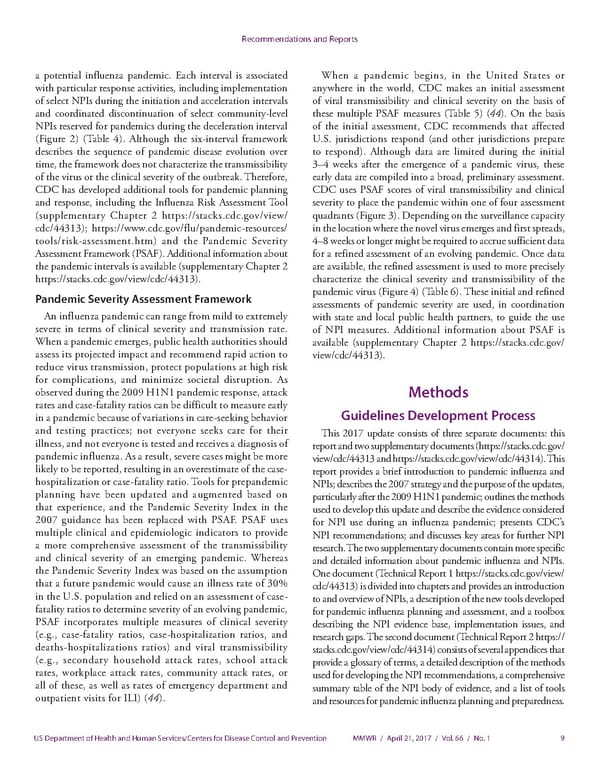Recommendations and Reports a potential influenza pandemic. Each interval is associated When a pandemic begins, in the United States or with particular response activities, including implementation anywhere in the world, CDC makes an initial assessment of select NPIs during the initiation and acceleration intervals of viral transmissibility and clinical severity on the basis of and coordinated discontinuation of select community-level these multiple PSAF measures (Table 5) (44). On the basis NPIs reserved for pandemics during the deceleration interval of the initial assessment, CDC recommends that affected (Figure 2) (Table 4). Although the six-interval framework U.S. jurisdictions respond (and other jurisdictions prepare describes the sequence of pandemic disease evolution over to respond). Although data are limited during the initial time, the framework does not characterize the transmissibility 3–4 weeks after the emergence of a pandemic virus, these of the virus or the clinical severity of the outbreak. Therefore, early data are compiled into a broad, preliminary assessment. CDC has developed additional tools for pandemic planning CDC uses PSAF scores of viral transmissibility and clinical and response, including the Influenza Risk Assessment Tool severity to place the pandemic within one of four assessment (supplementary Chapter 2 https://stacks.cdc.gov/view/ quadrants (Figure 3). Depending on the surveillance capacity cdc/44313); https://www.cdc.gov/flu/pandemic-resources/ in the location where the novel virus emerges and first spreads, tools/risk-assessment.htm) and the Pandemic Severity 4–8 weeks or longer might be required to accrue sufficient data Assessment Framework (PSAF). Additional information about for a refined assessment of an evolving pandemic. Once data the pandemic intervals is available (supplementary Chapter 2 are available, the refined assessment is used to more precisely https://stacks.cdc.gov/view/cdc/44313). characterize the clinical severity and transmissibility of the Pandemic Severity Assessment Framework pandemic virus (Figure 4) (Table 6). These initial and refined assessments of pandemic severity are used, in coordination An influenza pandemic can range from mild to extremely with state and local public health partners, to guide the use severe in terms of clinical severity and transmission rate. of NPI measures. Additional information about PSAF is When a pandemic emerges, public health authorities should available (supplementary Chapter 2 https://stacks.cdc.gov/ assess its projected impact and recommend rapid action to view/cdc/44313). reduce virus transmission, protect populations at high risk for complications, and minimize societal disruption. As observed during the 2009 H1N1 pandemic response, attack Methods rates and case-fatality ratios can be difficult to measure early in a pandemic because of variations in care-seeking behavior Guidelines Development Process and testing practices; not everyone seeks care for their This 2017 update consists of three separate documents: this illness, and not everyone is tested and receives a diagnosis of report and two supplementary documents (https://stacks.cdc.gov/ pandemic influenza. As a result, severe cases might be more view/cdc/44313 and https://stacks.cdc.gov/view/cdc/44314). This likely to be reported, resulting in an overestimate of the case- report provides a brief introduction to pandemic influenza and hospitalization or case-fatality ratio. Tools for prepandemic NPIs; describes the 2007 strategy and the purpose of the updates, planning have been updated and augmented based on particularly after the 2009 H1N1 pandemic; outlines the methods that experience, and the Pandemic Severity Index in the used to develop this update and describe the evidence considered 2007 guidance has been replaced with PSAF. PSAF uses for NPI use during an influenza pandemic; presents CDC’s multiple clinical and epidemiologic indicators to provide NPI recommendations; and discusses key areas for further NPI a more comprehensive assessment of the transmissibility research. The two supplementary documents contain more specific and clinical severity of an emerging pandemic. Whereas and detailed information about pandemic influenza and NPIs. the Pandemic Severity Index was based on the assumption One document (Technical Report 1 https://stacks.cdc.gov/view/ that a future pandemic would cause an illness rate of 30% cdc/44313) is divided into chapters and provides an introduction in the U.S. population and relied on an assessment of case- to and overview of NPIs, a description of the new tools developed fatality ratios to determine severity of an evolving pandemic, for pandemic influenza planning and assessment, and a toolbox PSAF incorporates multiple measures of clinical severity describing the NPI evidence base, implementation issues, and (e.g., case-fatality ratios, case-hospitalization ratios, and research gaps. The second document (Technical Report 2 https:// deaths-hospitalizations ratios) and viral transmissibility stacks.cdc.gov/view/cdc/44314) consists of several appendices that (e.g., secondary household attack rates, school attack provide a glossary of terms, a detailed description of the methods rates, workplace attack rates, community attack rates, or used for developing the NPI recommendations, a comprehensive all of these, as well as rates of emergency department and summary table of the NPI body of evidence, and a list of tools outpatient visits for ILI) (44). and resources for pandemic influenza planning and preparedness. US Department of Health and Human Services/Centers for Disease Control and Prevention MMWR / April 21, 2017 / Vol. 66 / No. 1 9
 Community Mitigation Guidelines to Prevent Pandemic Influenza Page 10 Page 12
Community Mitigation Guidelines to Prevent Pandemic Influenza Page 10 Page 12